Memory Metal to Oobleck: NanoDays Makes Learning About Nanoscience Fun

Two NGS students demonstrate the part solid/part liquid properties of oobleck.
April 10, 2014
Last weekend, 22 6th–8th grade students from Next Generation School (NGS) participated in NanoDays, a program offering unique hands-on learning experiences about nanoscale science. The two-day event was held at the Champaign Public Library on Friday, April 4th, and the Orpheum Children's Science Museum on Saturday, April 5th. The role of NGS students was to demonstrate to NanoDays visitors the unique properties of nanoscale materials. However, besides learning a lot about nanoscience themselves, they also learned how to adapt their presentation so that not only their peers could understand, but an audience ranging from preschoolers to adults.
The NanoDays collaboration between the Orpheum and NGS began in 2010. Lacking the personnel to run NanoDays' eleven events, museum staff "borrowed" some NGS middle school students. Joe Muskin, a former Next Generation teacher and currently the Education Outreach Director at the Mechanical Science and Engineering Department, recalls that NGS students did such a bang-up job that the Orpheum offered them the job…permanently.
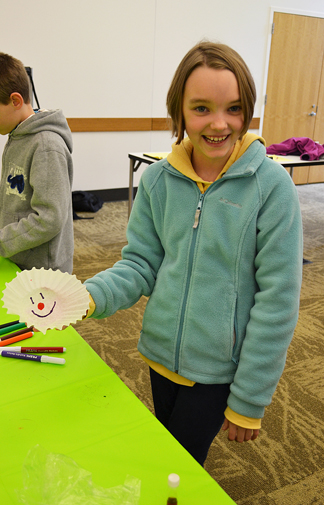
Ten-year-old Lauren displays the picture she drew to see the capillary action property in action.
"They looked from the very beginning for a group to do it," recalls Muskin, "and the first year, Next Generation did it, and they did such a good job, that they've been doing it ever since." So NanoDays 2014 was the fifth consecutive year that NGS students have staffed the event.
In addition to Muskin, the triumvirate responsible for training students, plus supervising the event, since the collaboration began includes NGS Head of School Chris Bronowski, and Carrie Kouadio, also a former NGS teacher and currently Program Coordinator for the Center for Nanoscale Science and Technology (CNST) and Knowledge Transfer/Site Coordinator for Emergent Behaviors of Integrated Cellular Systems (EBICS)
According to Kouadio, "It's a partnership that involves Next Generation School and the Orpheum Museum, but also involves the University. Joe and I have been involved over the years and actually training the students." Previously involved as NGS teachers, then as part of Nano-CEMMS's education outreach team, both have continued to be involved.
While student presenters are forced to brush up on their nanoscience, they also hone their presentation skills, something Muskin appreciates about NanoDays.
"They have to learn about their event, and they have to really understand it well, but they also have to learn how to present well. That includes things like not touching the equipment and telling the participant what to do. Also, answering questions and not trying to put them off."
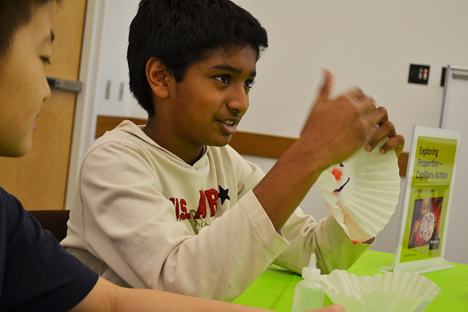
NGS student Krishna Subbiah displays the effect of capillary action on Lauren's drawing.
The mentors stressed another important principle when interacting with the public—one most young people today could practice implementing—restraint in cell phone use.
"Being ready when a person comes up—not texting or anything like that," adds Muskin.
After becoming well-versed in their nanoscience topics, students received training about what to do—and what not to do—when presenting.
"There are all of these little tips. What's kind of nice is that now there's a nice little video that shows them an example of a bad interaction and a good interaction," says Muskin.
Students also practiced their presentations ahead of time. Bronowski says they started practicing a couple of weeks ago during study hall.
But four students had a "practice" opportunity that was probably even more nerve-wracking than NanoDays itself. They appeared on WCIA's Morning Show: "A great experience," admits Bronowski, "because they were not necessarily given questions ahead of time. So it was very free flowing, and they had to do their presentations and answer questions."
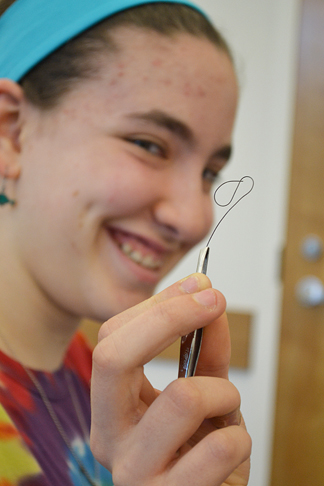
Above: NGS student Lia Dankowitz shows a strand of memory metal she curled up.
Below: Dankowitz shows how the strand has reverted to its "memorized" state (straight) after being placed in hot water.
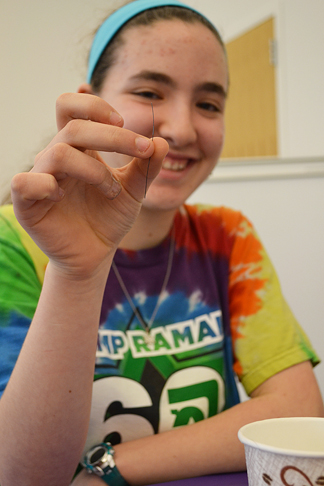
To provide activities for the 50 or so kids who annually show up at the library, and the 100 to 150 kids at the Orpheum, Next Generation sent 22 kids, their largest group yet. What is unique about the two venues is the different age groups of the audience: mostly middle school students normally attend the library event, while the Orpheum clientele tends to be younger, mostly preschoolers—which, according to Muskin, is a plus:
"That's actually really cool, because it makes these Next Generation kids be prepared for different levels of audience. You don't explain this the same way to a middle schooler that you do to a five-year-old, and it's kind of cool to watch the students really learn. How do you do that? How do you communicate to these different age groups?"
Pros at adapting instruction for variety of age groups, the mentors appear to have imparted some of their skills to their young charges.
"They take it very seriously," says Muskin. "That's one of the nice things about the Next Generation kids, is that they are very serious about it. They really practice their event so they know what to say, but also are really conscientious about making sure the people have a good interaction."
And like their mentors, the NGS students found communicating their knowledge to others to be quite rewarding.
For instance, after a detailed discourse on the properties and uses of Memory Metals, four NGS students demonstrated how to make the metals "remember" their previous shape. They also shared why they got involved with NanoDays.
"I am doing this because I think the most fun part of science is doing experiments to find out what you don't know," says Alice Correia. "Before Monday, I had no idea what memory metal was."
Isabel Scott enjoys both learning and teaching. "I like learning about science, and I just wanted to have this experience because I like teaching people about different things, and I like to talk. I talk a lot."
Excited to be presenting memory metal, Scott remembers dabbling with it in 2nd grade: "I had known about memory metal, but I didn't know it was in braces and the Mars Rover. It can do all of this cool stuff. I just remember holding it up and being like, "Whoa, that's so cool!"
Amelia had also experienced memory metal when she was younger: "I knew how cool it was, and I wanted to blow people's minds."
After acknowledging that she's not so great at "memorizing stuff," Lia Dankovitz admits why she participated: "I really love doing experiments. Also like Amelia, I had experience with this in like second grade, and it was really fun."
Wanting a very hands-on project, Samaia Jones and Anushka Agrawal chose the Oobleck experiment. Made famous in Dr. Seuss's Bartholomew and the Oobleck, oobleck was a gooey green substance that fell from the sky and stuck on everything. Made from cornstarch and water nowadays, oobleck is a liquid which acts like a solid when force is applied.
Jones appreciated their experiment's hands-on potential. "It's fun to kind of experiment with why these things happen, and it is fun to learn while you can put your hands on it, mess with it, and play with it."
"I really like doing extra science things," admits Agrawal, "and the sciences are interesting topics." Why did she choose oobleck? "Because I really like hands-on learning, and it is slimy."
At the station Sophie Quackenbush and Komal Kumaran were supervising, participants could "turn" nickels into pennies by applying copper electroplating.
Quackenbush volunteered for NanoDays and Electroplating in particular, because, "I thought it was fun, and I enjoy making things into different things, and changing the color. But I also just enjoy science in general."
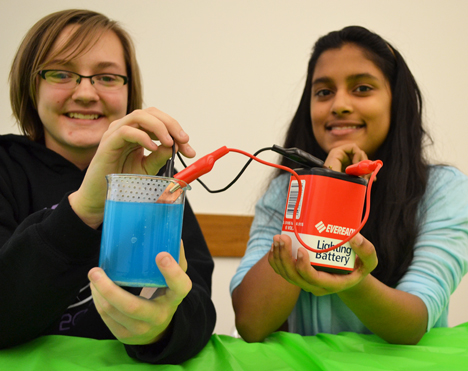
Sophie Quackenbush and Komal Kumaran ready to demonstrate electroplating to NanoDays visitors.
Involved with NanoDays since 6th grade, eighth grader Kumaran enjoys sharing her interest in science. "I have been really interested in science from the beginning of middle school through now, and I thought it was fun to do these things, and it gets the kids involved."
Might teaching be in Kumaran's future? "I don't know. I think talking to the kids about it is a lot of fun. They are really excited, especially when they are doing hands-on activities. So I don't really know yet, but it maybe has to do with a little bit of teacher in me."
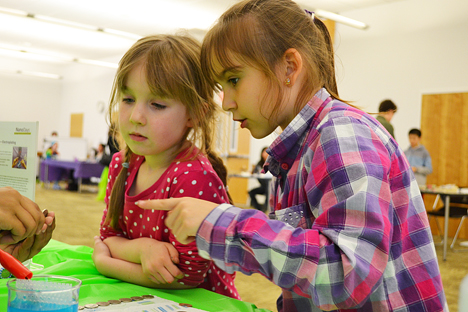
Seven-year-old Katrina (right) and six-year-old Alyssa watch a demonstration at the Electroplating station.
One local youngster who enjoyed Kumaran's hands-on activity about electroplating was seven-year-old Karina. Her mother, Sandy Jump, who regularly takes advantage of the Orpheum's learning opportunities, explains why she brought her daughter to NanoDays: "Because I want to enrich her life with all that is possible with education. I love science, and I just love her doing all the different projects that are available in the Champaign area. We are very involved with the Orpheum, and we love the girls to do science projects, and this just goes along with that category of things."
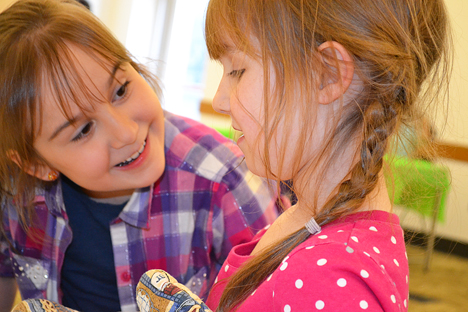
Katrina (left) and Alyssa put on oven mitts in preparation for an activity demonstrating how difficult nanoscience research is for scientists, because nanoparticles are so small. After putting on the mitts, participants tried to put together a Lego figure.
Next Generation middle school student Amelia Goldenbaum explains why she does NanoDays. "I did it last year for the first time because I really enjoy science, and I think doing experiments in fun, and I think learning through little kids is important. So I did this last year, and I had a really fun time just doing this with my friends. This year when the opportunity came, I couldn't pass it up."
Sixth-grader Silas Jones chose to participate, "Because I just really like sciencey things." He chose his project because "Magnets interest me, because you can hold things in place without nearly as much force as pulling stuff. Like magnetic cranes are the best methods for transporting cars that are broken for short distances. I really like them because they're cool."
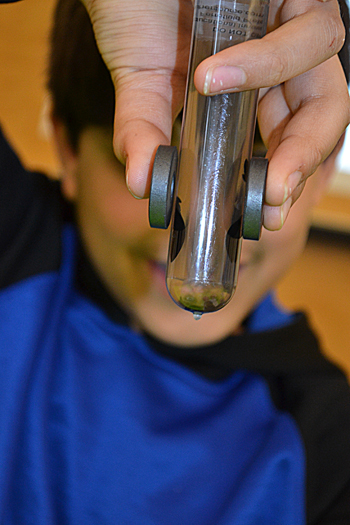
An NGS student demonstrates how magnets impact the materials in a test tube.
His partner, Mustafa Syed, agrees. "I really enjoy science; it is my favorite subject at school." He too loves magnets, and admits to fond memories playing with refrigerator magnets when he was a kid. "I just loved having magnets stick together, and I always wondered how they did that. Then I learned about why they stick together, it was the magnetic field and all of that stuff."
Begun in 2008 by NISE (the Nanoscale Informal Science Education Network), NanoDays is a national event; NanoDays 2014 took place March 29-April 6, 2014, at museums and other institutions across the country. Institutions who wanted to hold NanoDays could request kits for the events. While the event started with 50 participating sites in 2008, it has grown to 200+ participating institutions over the last seven years.
Story and photographs by Elizabeth Innes, Communications Specialist, I-STEM Education Initiative.
More: 6-8 Outreach, K-6 Outreach, Next Generation School, Orpheum, 2014
For further information regarding Next Generation School's partnership with the University of Illinois, see these additional I-STEM articles:
- Next Generation School's Science and Engineering Fair: Every Student Is a Winner.
- Next Generation School Fair: Tomorrow's Scientists & Engineers Meet Today's.
- BTW Kindergarteners Have a Ball Learning About Polymers, Manufacturing.
- Local Teacher Uses Project Lead the Way to Prepare Next Generation of Engineers;
- MechSE Gives Back to the Community.













.jpg)
















